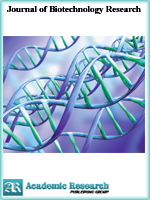Journal of Biotechnology Research
Online ISSN: 2413-3256
Print ISSN: 2413-8878
Print ISSN: 2413-8878
Quarterly Published (4 Issues Per Year)

Archives
Volume 4 Number 8 August 2018
Optimization of Amylase Production from Bacillus Cereus Using Solid State Fermentation
Authors: A. Rajani Chowdary ; Palkar Omkar Prakash ; Walawalkar Ankita kishor
Pages: 58-65
Abstract
Aim: Amylases are the extracellular enzymes which catalyze the hydrolysis of carbohydrates contain glucose as monomers and attracted a worldwide enzyme market due to their potential applications in various industries like food, pharmaceutical, textile industries etc. The present study was conducted to isolate and characterize the high yielding amylase producer isolated from marine water sample using various natural and synthetic carbon sources for fermentation. Methodology and Results: Bacillus cereus was isolated from marine water (Visakhapatnam, India) for the production of extracellular amylase enzyme. The isolate was examined for the extracellular amylase production using starch agar media and results showed a large clearance zone in the starch agar plate which indicates that it was able to produce amylase in a considerable quantity. The production of enzyme by the B.cereus was initially detected using Pikovskaya’s medium at temperature 37oC, pH 7.0 for 24h of incubation time. The various process parameters were optimized, pH, temperature, various natural and synthetic carbon sources respectively. The optimal conditions for the production of amylase enzyme were found at temperature 37oC (1890 µg/ml) and pH 6.0 (2000 µg/ml). Among the various synthetic carbon sources tested for optimum production lactose sugar will much enhances the production 5520µg/ml at 1% sugar concentration and in natural carbon sources maximum amount was produced with jaggery 2140 µg/ml at 5% concentration. Conclusion, Significance and Impact of Study: From the study it was concluded that Bacillus cereus was the efficient α-amylase enzyme producer by utilization of various synthetic and natural carbon sources for fermentation. A considerable interest can be given in using jaggery, wheat flour and barley as an alternative sources of carbon for α-amylase production by Bacillus cereus and makes the production economically feasible at industrial level.



